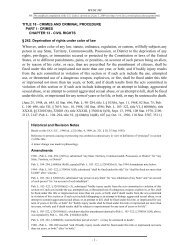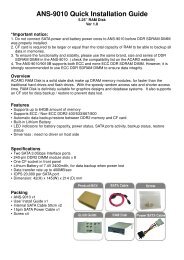2004 Instructions for Form 1040 (ALL) - Supreme Law Firm
2004 Instructions for Form 1040 (ALL) - Supreme Law Firm
2004 Instructions for Form 1040 (ALL) - Supreme Law Firm
Create successful ePaper yourself
Turn your PDF publications into a flip-book with our unique Google optimized e-Paper software.
<strong>Form</strong> <strong>1040</strong>—Lines 41 and 43<br />
Tax Table or Tax Computation Work- Schedule D Tax Worksheet. If you have to<br />
Line 43<br />
sheet. If your taxable income is less than file Schedule D and Schedule D, line 18 or<br />
$100,000, you must use the Tax Table that 19, is more than zero, use the Schedule D<br />
Tax begins on page 60 to figure your tax. Be Tax Worksheet on page D-9 of the Instrucsure<br />
you use the correct column. If your tions <strong>for</strong> Schedule D to figure your tax.<br />
Do you want the IRS to figure your tax <strong>for</strong><br />
you?<br />
taxable income is $100,000 or more, use<br />
Qualified Dividends and Capital Gain Tax<br />
the Tax Computation Worksheet on<br />
Yes. See Pub. 967 <strong>for</strong> details, in- Worksheet. If you do not have to use the<br />
page 72.<br />
cluding who is eligible and what to do. If<br />
Schedule D Tax Worksheet (see above),<br />
you have paid too much, we will send you a<br />
However, do not use the Tax Table or use the worksheet on page 34 to figure your<br />
refund. If you did not pay enough, we will<br />
Tax Computation Worksheet to figure your tax if any of the following apply.<br />
send you a bill.<br />
tax if any of the following apply.<br />
• You reported qualified dividends on<br />
<strong>Form</strong> 8615. <strong>Form</strong> 8615 must generally be <strong>Form</strong> <strong>1040</strong>, line 9b.<br />
No. Use one of the following methused<br />
to figure the tax <strong>for</strong> any child who was • You do not have to file Schedule D<br />
ods to figure your tax. Also include in the<br />
total on line 43 any of the following taxes.<br />
under age 14 at the end of <strong>2004</strong>, and who and you reported capital gain distributions<br />
had more than $1,600 of investment in- on <strong>Form</strong> <strong>1040</strong>, line 13.<br />
1. Tax from <strong>Form</strong>s 8814 and 4972. Be come, such as taxable interest, ordinary • You are filing Schedule D and Schedsure<br />
to check the appropriate box(es). dividends, or capital gains (including capiule<br />
D, lines 15 and 16, are both more than<br />
2. Tax from recapture of an education tal gain distributions). But if neither of the<br />
zero.<br />
credit. You may owe this tax if (a) you child’s parents was alive at the end of <strong>2004</strong>,<br />
claimed an education credit in an earlier do not use <strong>Form</strong> 8615 to figure the child’s Schedule J. If you had income from farm-<br />
year, and (b) you, your spouse if filing tax. Also, a child born on January 1, 1991, ing or fishing, your tax may be less if you<br />
jointly, or your dependent received in <strong>2004</strong> is considered to be age 14 at the end of choose to figure it using income averaging<br />
either tax-free educational assistance or a <strong>2004</strong>. Do not use <strong>Form</strong> 8615 <strong>for</strong> such a on Schedule J.<br />
refund of qualified expenses. See <strong>Form</strong> child.<br />
8863 <strong>for</strong> more details. If you owe this tax,<br />
enter the amount and “ECR” on the dotted<br />
line next to line 43.<br />
Deduction <strong>for</strong> Exemptions Worksheet—Line 41<br />
Keep <strong>for</strong> Your Records<br />
1. Is the amount on <strong>Form</strong> <strong>1040</strong>, line 37, more than the amount shown on line 4 below <strong>for</strong> your filing status?<br />
No. STOP Multiply $3,100 by the total number of exemptions claimed on <strong>Form</strong> <strong>1040</strong>, line 6d, and enter the<br />
result on line 41.<br />
Yes. Continue<br />
<br />
2. Multiply $3,100 by the total number of exemptions claimed on <strong>Form</strong> <strong>1040</strong>, line 6d .................. 2.<br />
3. Enter the amount from <strong>Form</strong> <strong>1040</strong>, line 37 ................................. 3.<br />
4. Enter the amount shown below <strong>for</strong> your filing status.<br />
• Single—$142,700<br />
• Married filing jointly or qualifying widow(er)—$214,050<br />
• Married filing separately—$107,025<br />
• Head of household—$178,350<br />
5. Subtract line 4 from line 3. If the result is more than $122,500 ($61,250 if married<br />
}<br />
.....<br />
4.<br />
filing separately), STOP You cannot take a deduction <strong>for</strong> exemptions ............... 5.<br />
6. Divide line 5 by $2,500 ($1,250 if married filing separately). If the result is not a whole<br />
number, increase it to the next higher whole number (<strong>for</strong> example, increase 0.0004 to 1) 6.<br />
7. Multiply line 6 by 2% (.02) and enter the result as a decimal .................................. 7. .<br />
8. Multiply line 2 by line 7 ........................................................... 8.<br />
9. Deduction <strong>for</strong> exemptions. Subtract line 8 from line 2. Enter the result here and on <strong>Form</strong> <strong>1040</strong>, line 41 . . . 9.<br />
-33- Need more in<strong>for</strong>mation or <strong>for</strong>ms? See page 7.













